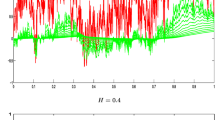Abstract
Fractional Brownian motion (FBM) provides a useful model for many physical phenomena demonstrating long-term dependencies and 1/f-type spectral behavior. In this model, only one parameter is neeessary to describe the complexity of the data,H, the Hurst exponent. FBM is a nonstationary random function not well suited to traditional power spectral analysis however. In this paper we discuss alternative methods for the analysis of FBM, in the context of real-time biomedical signal processing. Regression-based methods utilizing the power spectral density (PSD), the discrete wavelet transform (DWT), and dispersive analysis (DA) are compared for estimation accuracy and precision on synthesized FBM datasets. The performance of a maximum likelihood estimator forH, theoretically the best possible estimator, are presented for reference. Of the regression-based methods, it is found that the estimates provided by the DWT method have better accuracy and precision forH>0.5, but become biased for low values ofH. The DA method is most accurate forH<0.5 for a 256-point data window size. The PSD method was biased for bothH<0.5 andH>0.5.
Similar content being viewed by others
References
Akay, M. Wavelets in biomedical engineering.Ann. Biomed. Eng. 23:531–542, 1995.
Bassingthwaighte, J. B., and G. M. Raymond. Evaluation of the dispersional analysis method for fractal time series.Ann. Biomed. Eng. 23:491–505, 1995.
Beran, J. Statistical methods for data with long-range dependence.Statistical Sci. 7:404–427, 1992.
Christini, D. J., A. Kulkarni, S. Rao, E. R. Stutman, F. M. Bennett, J. M. Hausdorff, N. Oriol, and K. R. Lutchen. Influence of autoregressive model parameter uncertainty on spectral estimates of heart rate dynamics. ABME 23:127–134, 1995.
Daubechies, I. Orthonormal bases of compactly supported wavelets.Comm. Pure Appl. Math. 44:909–996, 1988.
DeBoer, R. W., J. M. Karemaker, and J. Strackee. Comparing spectra of a series of point events particularly for heart rate variability data.IEEE Trans. Biomed. Eng. BME-31: 384–387, 1984.
Feder, J. Fractals. New York: Plenum Press, 1988, 310 pp.
Flandrin, P. On the spectrum of fractional Brownian motion.IEEE Trans. Inform. Theor. 35:197–199, 1989.
Flandrin, P. Wavelet analysis and synthesis of fractional Brownian motion.IEEE Trans. Inform. Theor. 38:910–917, 1992.
Kaplan, L. M., and C. C. Jay Kuo. Fractal estimation from noisy data via discrete fractional Gaussian noise (DFGN) and the Haar basis.IEEE Trans. Signal Proc. 41:3554–3562, 1993.
Keshner, M. S. 1/f noise.Proc. IEEE 70:212–218, 1982.
Kobayashi, M., and T. Musha. 1/f fluctuation of heartbeat period.IEEE Trans. Biomed. Eng. BME-29:456–457, 1982.
Lundahl, T., W. J. Ohley, S. M. Kay, and R. Siffert. Fractional Brownian motion: A maximum likelihood estimator and and its application to image texture.IEEE Trans. Med. Imag. MI-5:152–161, 1986.
Mallat, S. G. A theory for multiresolution signal decomposition: The wavelet representation.IEEE Trans. PAMI 11: 674–693, 1989.
Mandelbrot, B. B., and J. W. Van Ness. Fractional Brownian motions, fractional noises and applications.SIAM Rev. 10:422–437, 1968.
Saul, J. P., P. Albrecht, R. D. Berger, and R. J. Cohen. Analysis of long term heart rate variability: Methods, 1/f scaling and implications.Comp. Cardiol. 14:419–422, 1987.
Schepers, H. E., J. H. G. M. van Beeck, and J. B. Bassingthwaighte. Four methods to estimate the fractal dimension from self-affine signals.IEEE Eng. Med. Biol. Magazine. 11 (June):57–64, 1992.
Tewfik, A. H., and M. Kim. Correlation structure of discrete wavelet coefficients of fractional Brownian motion.IEEE Trans. Inform. Theor. 38:904–909, 1992.
Voss, R. F. Fractals in nature: From characterization to simulation. In: The Science of Fractal Images, edited by H. O. Peitgen and D. Saupe. New York: Springer-Verlag, 1988, pp. 21–70.
Wornell, G. W., and A. V. Oppenheim. Estimation of fractal signals from noisy measurements using wavelets.IEEE Trans. Signal Proc. 40:611–623, 1992.
Yamamoto, Y., and R. L. Hughson. Coarse-graining spectral analysis: New method for studying heart rate variability.J. Appl. Physiol. 71:1143–1150, 1991.
Author information
Authors and Affiliations
Rights and permissions
About this article
Cite this article
Fischer, R., Akay, M. A comparison of analytical methods for the study of fractional brownian motion. Ann Biomed Eng 24, 537–543 (1996). https://doi.org/10.1007/BF02648114
Received:
Revised:
Accepted:
Issue Date:
DOI: https://doi.org/10.1007/BF02648114




